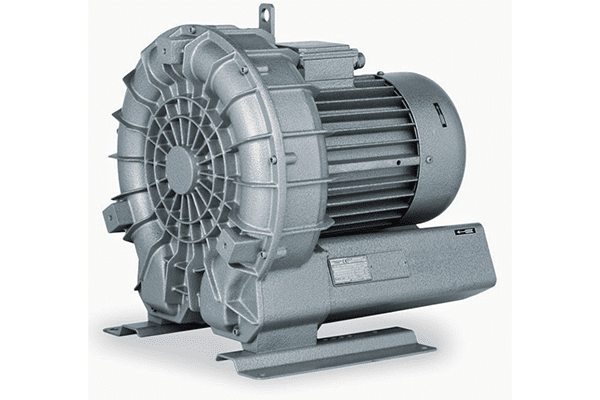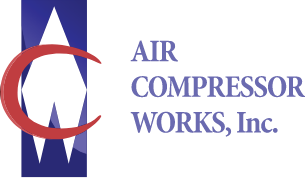Air Compressor Works
Post
Compressor Basics: Side Channel
October 20, 2017

Elmo Rietschle makes one as small as a CD that weighs less than a 1/2 lb. They also make them as large as 700 lbs.
So let’s look at how they compress air – I’ll just copy verbatim from Rietschle’s literature, because they explain it very well:

As it enters the side channel (2), the rotating impeller (3) imparts velocity to the gas in the direction of rotation.
Centrifugal force in the impeller blades accelerates the gas outward and the pressure increases.
Every rotation adds kinetic energy, resulting in further increase of pressure along the side channel.
The side channel narrows at the rotor, sweeping the gas off the impeller blades and discharging it through the outlet silencer
(4) where it exits the pump.
In this case, the impeller is just a fancy fan. It spins really fast inside the housing and creates pressure or vacuum, depending on which side you hook it up to. Actually, every compressor creates both pressure and vacuum, but side-channel is one of the few technologies where you can use the same pump for both with no modification. For instance, a piston compressor creates a vacuum on its inlet, but you can’t just hook a pipe up to it and use it in your process. With a side-channel pump, you can.
This the first dynamic compressor that we have spotlighted. As we mentioned before, a dynamic compressor uses a rotating element to accelerate the air and then forces it into a smaller space. I like to think of it as a traffic jam on the interstate that happened because some lanes are blocked off, and the cars are the air molecules. The cars are jammed tighter together because of the lane blockage. More cars jammed together in a tighter area is the higher pressure.
Unlike a bad day on I-95, however, side-channel technology is very useful.
Here are some applications where you’ll find side-channel blowers:
| Central vacuum systems | Packaging industry |
| Degasification of food | Assembling and folding packaging materials |
| Dental vacuum | Vacuum packaging |
| Drying out buildings | Plastics industry |
| Filling bags / bottles / silos | Contact free plastic film redirection |
| Fishpond ventilation | Cooling and drying extruder products |
| Gas analysis | EPS foaming |
| Industrial vacuum cleaners | Granulate conveying |
| Laser printers | Plastic welding |
| Pneumatic conveying | Thermoforming |
| Swimming pool technology / jacuzzis | Printing and paper industry |
| Letter sorting / enveloping | Textile industry |
| Lifting and holding parts using vacuum suction | Ventilation of sewage treatment plants |
| Soil remediation |
Side-channel blowers and vacuum pumps have a lot of benefits:
- Very little or no maintenance
- 100% duty cycle
- If sized correctly, they last a very long time
- Very clean, no oil or lubricants at all in the pump
- The same pump can be used for pressure or vacuum
- They are usually quieter than other technologies that offer the same pressure and flow
A good example is the Rietschle Velocis series. It will run 40,000 hours flat out before you need to do any maintenance. There are 8760 hours in a year, so it could run 4-1/2 years non-stop without you needing to touch it. Of course, your usual work week for a compressor like this is 40-80 hours, so that’s between 9 and 19 years before any maintenance or parts are needed.
Of course, many of you haven’t heard of these before, so there must be some drawbacks.
Here they are:
- The range of vacuum and pressure they can supply is very small. The most pressure out of the ones I’ve seen is 15 psi, and that’s a special 3-stage version. Normally they operate between 3 and 10 psi. That’s not a lot of pressure. The same is true for using it to create a vacuum. They don’t create a deep vacuum. This limits their use to special applications that need very little pressure or a very light vacuum.
- They are very tricky to size properly. Most of these blowers are used by OEM manufacturers as part of an engineered package. The sizing was done by the engineers at the factory. Unless you are extremely knowledgeable about compressed air or vacuum, you’re not going to pick one out of a brochure and put it in your shop. Well, actually you can, but the odds of you choosing the wrong one are high.
Those are really the only cons, and they aren’t bad points – you shouldn’t use any technology outside of the limitations it was designed for. If you need to supply a continuous flow of under 10 psi, side channel blowers are usually the way to go. However, you should have a professional to help you pick one out. Once sized correctly, side channel compressors will give you years, maybe decades, of worry-free service.
Contact Us
Contact Us
Palm beach:
1956 W 9th St
Riviera Beach, FL 33404
Monday – Friday 7:30 AM - 4:30 PM
Map and Directions
Miami:
7292 NW 25th St
Doral, FL 33122
Monday – Friday 7:30 AM - 4:30 PM
Map and Directions
Phone Number:
Areas We Serve
- Miami
- Fort Lauderdale
- Hollywood
- Boca Raton
- Stuart
- Vero Beach
- Delray Beach
- West Palm Beach
- Homestead
- Key West
- Fort Pierce





